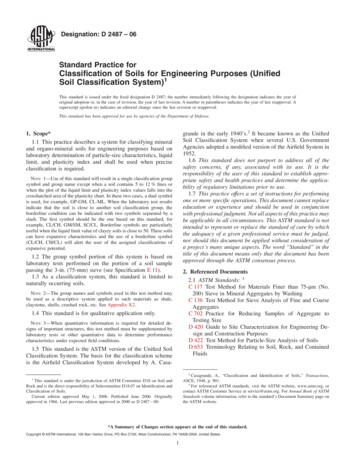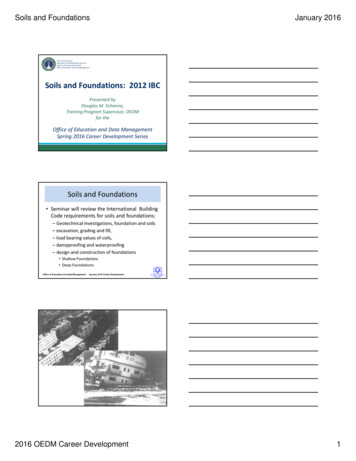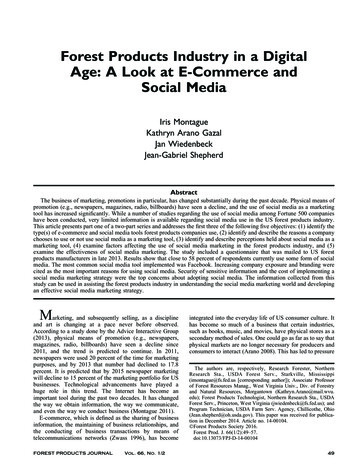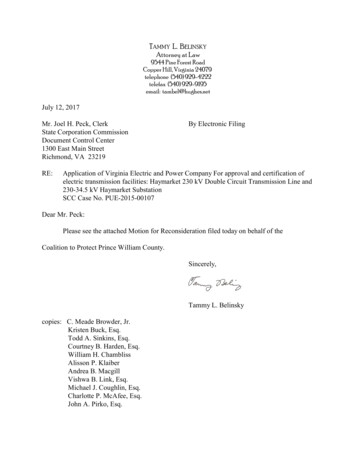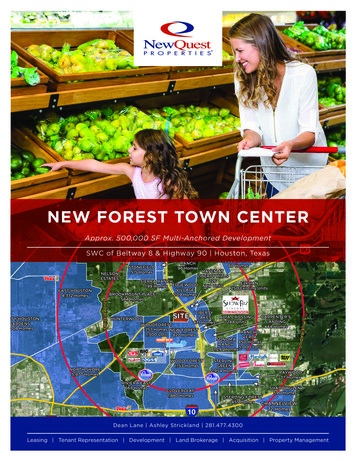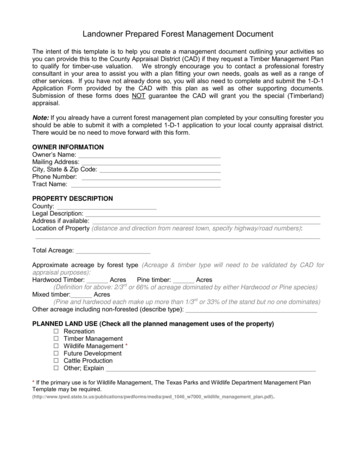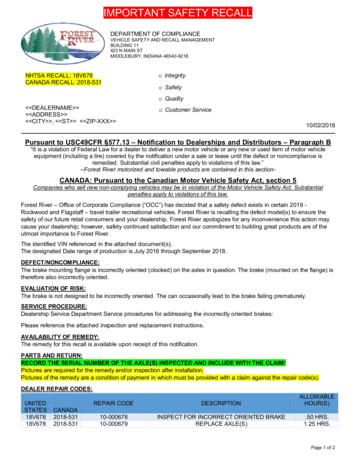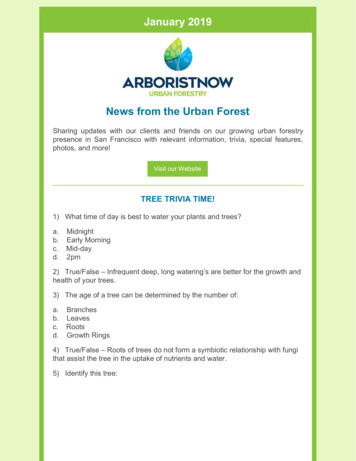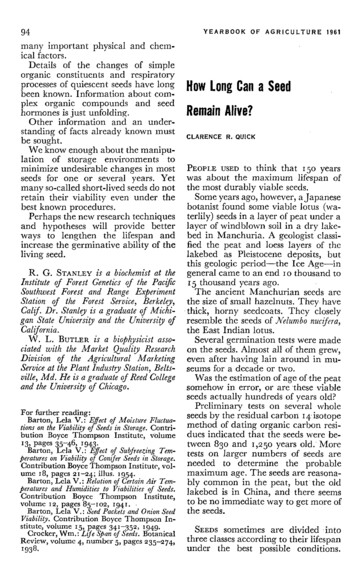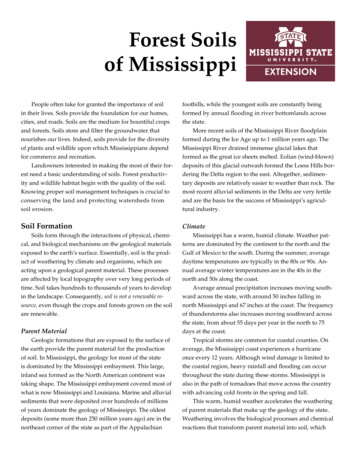
Transcription
Forest Soilsof MississippiPeople often take for granted the importance of soilin their lives. Soils provide the foundation for our homes,cities, and roads. Soils are the medium for bountiful cropsand forests. Soils store and filter the groundwater thatnourishes our lives. Indeed, soils provide for the diversityof plants and wildlife upon which Mississippians dependfor commerce and recreation.Landowners interested in making the most of their forest need a basic understanding of soils. Forest productivity and wildlife habitat begin with the quality of the soil.Knowing proper soil management techniques is crucial toconserving the land and protecting watersheds fromsoil erosion.foothills, while the youngest soils are constantly beingformed by annual flooding in river bottomlands acrossthe state.More recent soils of the Mississippi River floodplainformed during the Ice Age up to 1 million years ago. TheMississippi River drained immense glacial lakes thatformed as the great ice sheets melted. Eolian (wind-blown)deposits of this glacial outwash formed the Loess Hills bordering the Delta region to the east. Altogether, sedimentary deposits are relatively easier to weather than rock. Themost recent alluvial sediments in the Delta are very fertileand are the basis for the success of Mississippi’s agricultural industry.Soil FormationClimateSoils form through the interactions of physical, chemical, and biological mechanisms on the geological materialsexposed to the earth’s surface. Essentially, soil is the product of weathering by climate and organisms, which areacting upon a geological parent material. These processesare affected by local topography over very long periods oftime. Soil takes hundreds to thousands of years to developin the landscape. Consequently, soil is not a renewable resource, even though the crops and forests grown on the soilare renewable.Mississippi has a warm, humid climate. Weather patterns are dominated by the continent to the north and theGulf of Mexico to the south. During the summer, averagedaytime temperatures are typically in the 80s or 90s. Annual average winter temperatures are in the 40s in thenorth and 50s along the coast.Average annual precipitation increases moving southward across the state, with around 50 inches falling innorth Mississippi and 67 inches at the coast. The frequencyof thunderstorms also increases moving southward acrossthe state, from about 55 days per year in the north to 75days at the coast.Tropical storms are common for coastal counties. Onaverage, the Mississippi coast experiences a hurricaneonce every 12 years. Although wind damage is limited tothe coastal region, heavy rainfall and flooding can occurthroughout the state during these storms. Mississippi isalso in the path of tornadoes that move across the countrywith advancing cold fronts in the spring and fall.This warm, humid weather accelerates the weatheringof parent materials that make up the geology of the state.Weathering involves the biological processes and chemicalreactions that transform parent material into soil, whichParent MaterialGeologic formations that are exposed to the surface ofthe earth provide the parent material for the productionof soil. In Mississippi, the geology for most of the stateis dominated by the Mississippi embayment. This large,inland sea formed as the North American continent wastaking shape. The Mississippi embayment covered most ofwhat is now Mississippi and Louisiana. Marine and alluvialsediments that were deposited over hundreds of millionsof years dominate the geology of Mississippi. The oldestdeposits (some more than 250 million years ago) are in thenortheast corner of the state as part of the Appalachian
occur faster as the temperature rises. Water is the universalsolvent and provides the means for weathering. Rainwateris slightly acidic due to dissolved carbonic acid, which hastens the weathering of minerals from these sediments.Consequently, the soils of the Coastal Plain are moreweathered than those in river bottomlands. The soils of theriver bottoms, including the Mississippi River floodplains,are much more variable than Coastal Plain soils in termsof fertility, degree of weathering, and development. Thishas implications for agriculture, forestry, and wildlifemanagement.Pine and oak vegetation tend to produce organic acidsupon decomposition due to their oleoresins and tannins,respectively. Their decomposition will tend to acidify soils,which further accelerates mineral weathering of geologicsediments.Prehistoric humans also influenced the Mississippilandscape through the use of fire. As Native Americancultures developed agriculture, humans used fire more extensively. This tool was used to clear land for farming andto keep hunting grounds open. Consequently, pre-Columbian civilizations created a mosaic of villages, agriculturalfields, and extensive woodland-savannas in Mississippi.Therefore, the native vegetation adapted to very frequentburning.OrganismsMississippi has a great variety of vegetation fromnorth to south and east to west, forming major eco-regionsacross the state. These include the Mississippi Delta, whichis dominated by agriculture and bottomland hardwoodforests of oak-gum-cypress. Forests in the Delta includenumerous bottomland species, such as bald cypress, willow oak, swamp chestnut oak, cottonwood, black willow,green ash, sugarberry, and swamp hickory.To the east of the Delta are the Loess Hills. The vegetation in the Loess Hills region is dominated by cherrybarkoak, yellow poplar, water oak, mockernut hickory, andsweetgum. Also, these soils have some of the highest productivity for loblolly pine in the state.The northern section of the state is within the UpperGulf Coastal Plain. Vegetation is dominated by oak-pineand oak-hickory forests. Common species here includeshortleaf and loblolly pine, upland oaks (such as southernred, white, post, scarlet, black, and blackjack), hickory, andsweetgum.The Blackland Prairie region has soils with relativelyhigh alkalinity. Vegetation in this region must be tolerant of higher soil pH, such as Eastern redcedar, post oak,blackjack oak, shumard oak, and hickory.The Lower Coastal Plain and Northern Gulf of Mexicoregions are dominated by upland forests of longleaf pine,slash pine, and upland oaks (such as live, southern red,and turkey). Longleaf pine is well adapted to the frequent,low-intensity fires that burned across this landscape. Slashpine, while tolerant of fire as a mature tree, is less tolerant as a seedling or sapling and needs to be kept in wettersites. Live oak is very hardy and tolerates the high windsof tropical storms and salt spray along the coast. Bottomland species in this region include American elm, bald cypress, green ash, sugarberry, water oak, and red maple.TopographyThe effects of topography on soil formation occur on asmaller, local scale. First, the local relief of the land affectsthe internal drainage of water through the soil. A common observation is that soils on higher positions in thelandscape, such as ridges, are dry, whereas those in lowerpositions, such as ravines and wide floodplains, are wet.These differences in drainage will affect the types of chemical reactions involved in the weathering of parent materialinto soil.Secondly, available moisture in the soil has a tremendous influence on the kinds of vegetation growing acrossthe landscape. This, in turn, affects the animals living inthese areas. Altogether, these differences in the plant andanimal communities from one area to the next will also influence the weathering of parent materials into soil.TimeThe floodplains are the youngest, most fertile, andmost highly variable soils. Otherwise, the soils found inMississippi tend to be very old. These old soils are highlyweathered and lower in nutrients than river bottomlands.Certainly, prehistoric vegetation was very differentthan today’s. However, it still responded to changes insoils and climate. As the last Ice Age was ending, 10,000to 12,000 years ago, beech, hornbeam, oak, white pine,and hemlock dominated Mississippi forests. As vegetation adapted to cooler climates, weathering processes alsochanged and slowed.Yet, as vegetation developed on bare ground, organicmatter was gradually incorporated into the soil-formingprocesses. As the climate warmed, the forest composi-2
O Horizontion in Mississippi gradually developed to that which isseen today, with the southern pines, oaks, red maple, andsweetgum. Further, the organic acids from decaying pineneedles and oak leaves accelerated the weathering process.The O horizon is on the soil surface and consists ofleaves, branches, and other organic materials in varyingstages of decomposition. In forests, this horizon is dividedinto the litter and duff layers. While the O horizon is nota part of mineral soil, it is very important. It is in the litterand duff layers that organic material is recycled, with nutrients being returned to the soil through decomposition.These layers also help prevent wind and water erosion ofsoil particles.Describing Soil LayersOver time, soil-forming processes transform geologicalparent material into soil. Intensive weathering of the topsoil occurs near the soil surface. This weathering dissolvesand transports minerals downward through the soil. Asthe minerals move downward, the chemical and physicalinteractions in the soil change, with new minerals createdand deposited. This results in the formation of layers, orhorizons, in the soil. These layers are characteristic of thegeology, hydrology, chemistry, and vegetation on a site.Horizons and their properties are used to describe the soil(Figure 1). Horizons are called O, A, E, B, C, and R.A HorizonThe A horizon is called topsoil. It is a combination ofmineral soil and organic matter that has been incorporatedfrom the litter layer. The topsoil is a zone of leaching, aswater moving through the soil washes minerals off soilparticles.E HorizonO horizonOccasionally, there is a layer beneath the topsoil calledthe E horizon, which is also a zone of intense leaching.Consequently, this layer is comprised predominantly ofwashed sand grains. This layer is commonly found in thehighly weathered soils of the Lower Coastal Plain andCoastal Flatwoods in southern Mississippi.A horizonB HorizonThe B horizon is the beginning of the subsoil. This isa zone of accumulation, usually of clay minerals or compounds of iron, aluminum, and organic complexes. Formany Mississippi soils, it is generally the next most fertilehorizon after the A horizon.E horizonC HorizonThe C horizon is usually deeper subsoil, considered tobe the residual parent material from which the soil formed.It bears the effects of weathering but with relatively littleinfluence from soil organisms, as compared to the O, A, E,and B horizons.B horizonR HorizonThe R horizon is found beneath the C horizon and isthe original bedrock. In Mississippi, the R horizon is foundin the soils of the Appalachian foothills, in the northeastern-most corner of the state.Figure 1. Illustration of soil horizons. Photo by J.D. Kushla.3
Soil PropertiesSoil PorosityThere are several soil chemical and physical propertiesthat are important to forest management. They are organicmatter, texture, porosity, drainage, and soil pH. Thesephysical and chemical properties of the soil interact todetermine its fertility. This concept is known as “carryingcapacity.” Essentially, a given unit of land can produce aset amount of biomass, measured as yield. Below are moredetail descriptions of these key soil properties that are soimportant to soil fertility.Soil is not a solid mass. The spaces between soil particles are called pores, which allow for the movement ofwater and air through the soil. Porosity is measured as theproportion of void space in a given volume of soil. Ideally,nearly half the volume of soil should be pore space.Large pores allow internal drainage of water throughthe soil and aeration for roots. Small pores are essential forretaining water for root absorption.If the soil is too dense, plants cannot absorb sufficientwater and air from the soil. Insufficient pore space, therefore, may restrict root growth or even lead to plant death.Further, roots cannot penetrate highly compacted soilwhere pore space has been removed.Soil Organic MatterOrganic matter is a vital component to soil fertility. Organic matter helps retain plant nutrients and moisture. Italso helps the development of soil structure, which is howindividual soil particles bind together. Good soil structureleads to more and larger pore space, which is necessary forinternal drainage and adequate aeration for plant roots.Organic matter decomposes into acidic materials, whichfurther enhances chemical decomposition and weatheringand influences soil acidity.Plants and animals are the sources for organic matter. Since the natural vegetation for most of Mississippi isforest, organic matter often accumulates in litter and dufflayers atop the mineral soil. Soil organisms such as springtails and millipedes eat and break down the litter layer intofiner material that constitutes the duff layer. Other soil organisms, including fungi, microbes, and earthworms continue decomposition of the duff and further transform theorganic matter into humus. Eventually, some of the humusis mixed with the mineral soil to form the A horizon.Soil DrainageThe position of the soil in the landscape determinesthe depth to the seasonal water table. Wet soils (very poor,poor, and somewhat poorly drained) will have a highwater table for some time during the growing season. Rootgrowth may be limited due to excessive moisture and limited aeration for respiration. On the other hand, drier soils(moderately well, well, and excessively drained) have adeeper water table. As drainage improves on drier sites,moisture may become limited during the growing season.Soil pHSoil pH is a measure of acidity or alkalinity, which is theconcentration of hydronium ions in the soil solution on a negative logarithmic scale. A soil pH of 7 is neutral, a pH valueless than 7 is acidic, and a pH value greater than 7 is alkaline.The soil pH influences nutrient uptake and tree growth.Many soil nutrients change chemical form as a result ofreactions in the soil that are largely controlled by soil pH.Soils with a pH between 6.0 and 6.5 generally have the bestgrowing conditions with regard to soil chemistry. At thesepH levels, most nutrients are readily available. Nevertheless, the vast majority of commercially important tree species can live in a broad range of soil pH values as long asthe proper balance of required nutrients is maintained.Soil pH values at the extremes (less than 4.0 or greaterthan 8.5) can make some nutrients toxic and others unavailable to plants. At lower pH levels (less than 4.5), aluminum, iron, and manganese are very available for plantuptake, while at high pH levels (greater than 8.5), calciumand potassium are overabundant. In these situations, manyplants will take up too much of some nutrients and notenough of others. This is what causes toxic conditions.Soil TextureSoil texture is the proportion of different particle sizesof soil material. Sand has the largest particles, followedby silt, then clay. Texture can be determined by twomethods: separation of the size fractions in the lab, andby feel in the hand.Texture by feel in the hand is determined by how wellmoist soil sticks together. Sandy soils have individualgrains that feel gritty. If the soil holds its shape (known asa cast), it is loamy. If the cast can be rolled into thin ribbonsbetween the fingers, that indicates clay.Traditionally, clay soils were referred to as “heavy”because the soil stuck to the plow and made it heavy. Bycontrast, sandy soils were known as “light” soils becausethe sand grains did not stick to the plow.4
Figure 2. Major soil regions of Mississippi. Map used with permission from Dr. Larry Oldham.Major Soil Resource AreasDeltaIn Mississippi, there are several major soil resourceareas (Figure 2). These predominant soils and compositevegetation define major ecoregions across the state. Theseare the Delta, Loess Hills, Upper Coastal Plain, BlacklandPrairie, Lower Coastal Plain, and Flatwoods.The Delta region of western Mississippi is part of theMississippi River floodplain. Soils here are moist to wet,with medium to heavy texture. Most of this area is in agricultural production, with some in bottomland hardwoodsand a little in pasture. Soybeans, cotton, wheat, and rice arethe main crops.5
Loess HillsSoil ManagementAdjacent to the Delta to the east are the Loess Hills,formed from wind-blown glacial outwash some 10,000 to12,000 years ago. These silty upland soils are deep, welldrained, and fertile. Forest production predominates, although agricultural production of cotton, corn, soybeans,and wheat is important.Proper soil management requires a long-term commitment by landowners to sustain key soil properties. They must: protect the soil from erosion, maintain good physical condition of the soil, maintain proper balance of chemical characteristics,and maintain and enhance the organic components ofthe soil.Upper Coastal Plain and Interior FlatwoodsThe Upper Coastal Plain and Interior Flatwoods majorsoil regions are in the northeastern section of the state. Thesoils in these regions are older and more highly weathered,so they are less fertile than those to the west. These soilsdisplay advanced soil development, with well-definedtopsoil and subsoil horizons. Mixed pine-oak forests predominate, with loblolly and shortleaf pines and a varietyof upland and bottomland oaks. Major crops includesoybeans, corn, peanuts, and vegetables. Pastures are aminor crop.Management techniques will vary widely dependingupon land use, soil region, specific location, and topography of a given property.Landowners are strongly encouraged to obtain adetailed soil map of their property from the NaturalResources Conservation Service. These are available inthe local NRCS office or online at e.htm. These manuals provide a great deal of useful information, including drainage,fertility, best tree species to plant or manage, and development ratings.Site-level soil properties can be determined by the Mississippi State University Extension Service soil testing laboratory for a modest fee. Forms and soil sample boxes areavailable at the local county Extension office.Routine soil testing includes soil pH, lime requirements, and the amounts of available nutrients. If you specify a crop, fertilizer recommendations will be included, aswell. Many helpful publications on interpreting soil test results for timber, horticulture, agriculture, and wildlife foodplots are available at http://extension.msstate.edu. Searchunder the Publications link.Blackland PrairieInterspersed within the Coastal Plains is the BlacklandPrairie ecoregion. The Prairie soils bisect the northern andcentral portions of the state. Having developed from morechalky sediments, soils in this region are fine-textured withshrink-swell clays. While forestry is significant, there is agreater amount of pasture and cropland in this region.Lower Coastal Plain and Coastal FlatwoodsIn the southeastern corner of the state are the LowerCoastal Plain and the Coastal Flatwoods along the Gulfof Mexico. Predominant soils are sandy and wet with lownative fertility. Forests cover nearly 90 percent of the area.The proximity of the coast caused natural vegetation—including longleaf and slash pine and live oak forests—toadapt to tropical storms.6
For More InformationChapman, S. S., G. E. Griffith, J. M. Omernik, J. A. Comstock, M. C. Beiser, and D. Johnson. 2004. Ecoregions ofMississippi. U.S. Geological Survey. Reston, VA.Crouse, K. and W. McCarty. 2016. Soil Testing for the Farmer, Information Sheet 346. Mississippi State UniversityExtension Service, MS. 4p.Eyre, F. H., ed. 1980
formed during the Ice Age up to 1 million years ago. The Mississippi River drained immense glacial lakes that formed as the great ice sheets melted. Eolian (wind-blown) deposits of this glacial outwash formed the Loess Hills bor-dering the Delta region to the east. Altogether, sedimen-tary
